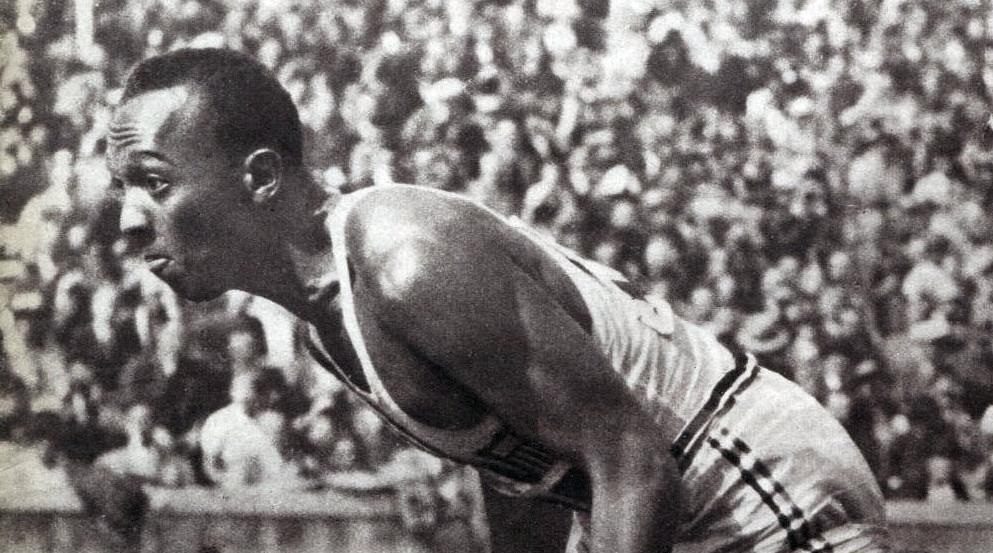
1936: The Florrie & The Berlin Olympiad
In 1936 Berlin, under the control of Hitler and the Nazi Party, was preparing to host what would be the last Olympic Games before the outbreak of World War II. Hitler saw the games as an opportunity to promote his government and ideals of racial supremacy and antisemitism. It almost went to plan with Germany winning 89 medals and topping the tables, that was until Jesse Owens stepped up to the podium.
In perhaps one of the most memorable moments in Olympic history Owens’ stand out performance totally overshadowed Germany. He won four gold medals in the sprint and long jump events and became the most successful athlete to compete in Berlin. Later he was credited by some with single-handedly crushing Hitler’s myth of Aryan supremacy.
Whilst searching through our archives we found the amazing story of W.Criggal, a youngster who was sent to the games to represent Liverpool & The Florrie. When he returned Criggal wrote a full report of his experiences for The Florencian, our official newspaper in back 1936.
Read his story here:
“On the occasion of the 11th Olympic Games, held at Berlin from the first to the sixteenth of August 1936, the German Government invited a group of thirty youths from each nation to stay at the Olympic Youth Camp. I was selected to represent Liverpool Boys’ Clubs in the British Group. We left Croyden by the German Air Liner ‘Von Hindenberg’, the largest aeroplane in Germany. It was a sunny day and we could see towns and rivers below us. The six hundred miles between Croyden and Berlin was covered in less than 5 hours. From Templehof Aerodrome we were taken by bus to the Camp.
The camp was surrounded by forest an only ten minutes from the stadium. We were warmly welcomed by the Germans and issued with “Identity Cards”, which allowed us to travel free on trams, trains and buses, and admitted us to the Olympic Games. So, although every ticket for the Games had been sold weeks before their commencement, we could walk in and out any time we wished.
Two days after our arrival we went to the Stadium to see the opening ceremony. Surrounding the huge stone stadium were the Swimming Stadium, Hockey Stadium, Polo Ground and other Arenas. The Zep, “Hindenberg” passed very low over the stadium immediately before the opening, and a hundred thousand spectators cheered and hands were raised in the Nazi salute as Herr Hitler arrived. After the German National Anthem had been played, trumpets were sounded, the flags of the nations were hoisted around the walls, and the Olympic Bell was rung for the first time as a sign for the athletes to enter. Many vivid uniforms were worn, but none were more artistic than the silver-grey coats and turbans of the Indians. After the teams had taken their places, the Fuehrer declared the Games open.
Then came the last of the torch bearers from Greece, who ran with his torch across the track, and lit the Olympic Flame on the tower of the Stadium.
This torch had been carried by a relay of 3000 runners from Olympia in Greece. The marching out of the teams completed the ceremonies.
Next day, we saw Jesse Owens breaking the world record, and also saw many world records broken, Lovelock and Whitlock scoring magnificent victories.
On Tuesday (Aug 4th) I met Captain Beckett (Uncle Stalky) and we went on a trip through Berlin, including the famous “Unter den Linden”, an avenue 200’ wide. Then we went to the Heidelberger Hoff (café) and, rather fed up with the sausage meals at Camp, I felt a new man after disposing of half a chicken, potatoes and salad, cherries and a glass of Neirsteiner wine. Afterwards, we spent hours exploring Berlin, seeing the Reichstag, Victory monument, the Ex-Kaiser’s palace and a tour of the War Museum, which contained a unique collection of ancient and modern weapons. On August 13th we went to Potsdam, a small but historical town in the lake district of Havel, 16 miles from Berlin. We visited the garrison church and we saw the burial vault of Frederick the Great. After lunch we went through the vast Sans Souci Park to the Palace of Saint Souci. We explored the Palace, the floors being so valuable that we had to wear felt slippers over our shoes. We went through the picture gallery, library, and music room, with its old fashioned flute and piano, we also visited Voltaire’s Room, and returned in the evening by river steamer.
Another long-awaited event was our visit to the Olympic Village, 9 miles from our camp. Built in picturesque surroundings, 3000 men athletes lived here as guest of the German Army; there were 150 houses each accommodating 24 athletes, in rooms containing double beds, and there were also community and recreation rooms. A gymnasium, swimming pool and sports ground were available for training. We were very sorry when the Olympic Games finished, on the 16th August, and we had to pack our bags. We were treated with the utmost courtesy by the German people throughout our visit, and, all good things coming to an end, we returned by air to England on Monday August 17th.
Now Boys! Get down to training in the gym and see about competing in the Olympic Games at Tokio, Japan, in 1940!”
Signed: W. Criggal
THE FLORENCE INSTITUTE
- 0151 728 2323
- info@theflorrie.org
- 377 Mill Street, L8 4RF
- We are open: 9am – 6pm Monday to Friday.
Registered Office: The Florence Institute Trust Ltd, 377 Mill Street, Liverpool L8 4RF. Charity Registration No: 1109301. Company Registration No: 05330850 (registered in England and Wales).
